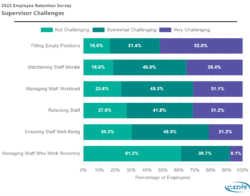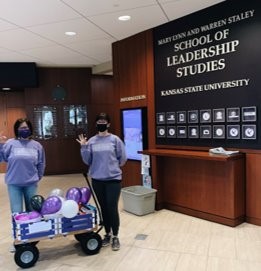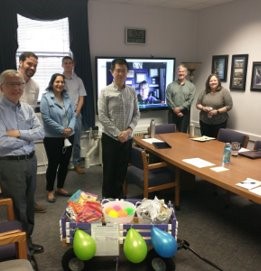by Julie Burrell | August 28, 2024
Editor’s Note: This is the second of two posts that explore the loneliness epidemic and practical ways HR can help combat it in the workplace.
Social bonds are as necessary to our well-being as a healthy diet, exercise and sleep, according to the Surgeon General’s 2023 report on the loneliness epidemic. The report recommends that workplaces make decreasing loneliness a strategic priority at all levels. Here is how higher ed HR can help prioritize social connection as a vital tool in supporting employee happiness and well-being.
Increase Inclusion to Fight Loneliness
Groups most at-risk for social isolation include “people with poor physical or mental health, disabilities, financial insecurity, those who live alone, single parents, as well as younger and older populations,” according to the report. Additionally, marginalized groups like the LGBTQ+ community may feel increased isolation.
Your inclusion and belonging initiatives might be the natural place to begin strengthening social connection on campus. Foreground accessibility in these initiatives by asking:
- Is social programming accessible for people with disabilities and people with mental health challenges?
- Is your programming inclusive of people who are neurodivergent?
- Are working parents, caregivers and remote employees unable to participate in on-site or off-hours socialization?
- Is cost a prohibitive factor for socializing?
- Are Employee Resource Groups or affinity groups supported in terms of budget and time within the workday?
Making Connections
Intergenerational Connections. Research suggests that making connections outside of our own age or social group may reduce the risks associated with loneliness. One inclusion strategy is to help bridge generational gaps by bringing younger and older people together, which also targets two of the most at-risk populations.
Volunteering with community groups that serve young and older people can also be effective in helping employees forge intergenerational connections (bonus: volunteering enhances employee satisfaction and engagement).
Campus and Community. Connecting with people of different social statuses has also been shown to improve well-being. How are leaders connecting with employees across campus in low-stakes ways?
Also consider how partnerships with your leadership, health centers, research faculty and student groups can make the dangers of loneliness a campus-wide concern.
How is your campus connecting with and enriching the larger community? According to the Surgeon General’s report, upward mobility is improved through relationship-building among people of differing socioeconomic status. (Register for our upcoming webinar to learn more about Duquesne University’s Minority Professional Development Internship Program, which was awarded CUPA-HR’s 2024 Inclusion Cultivates Excellence Award.)
Hybrid and Remote Employees
According to Gallup, fully remote employees report a higher level of loneliness (25%) than fully on-site employees (16%). At the same time, hybrid, remote and flexible work is an important strategy to retain top talent. And flexible work can be a boon to people with disabilities and neurodivergent employees.
This means that special considerations should be made for those workers who may not be on site every day.
Encourage online connections. Water cooler conversations are more difficult virtually. Consider establishing a rotating committee who can schedule casual chats online. Your internal communication tools, such as Teams and Slack, should have social spaces as well.
Model setting boundaries between work and home. Hybrid and remote opportunities are important in maintaining work-life balance, but remote employees may feel like they’re always “on.” The Surgeon General’s report recommends that workplaces “put in place policies that protect workers’ ability to nurture their relationships outside work.”
Beware of treating employees inconsistently. It’s important that managers find ways to boost face time with their remote or hybrid employees. For those employees who must be on site, provide what flexibility you can, such as summer Fridays off. Learn more about success in managing hybrid teams in Roadblocks to Supervision: Clearing a Path for Peer-to-Supervisors, New Supervisors and Hybrid Team Supervisors.
Starting With HR
Let’s face it: HR can sometimes feel like a lonely place. Whether you’re a CHRO, a department of one, or a member of a team navigating the increased scrutiny of a role in HR, you might feel like few people understand your own daily challenges beyond the CUPA-HR community. HR is so often tasked with helping others, but HR pros need support too.
Raising awareness about the basic need for social connection might help you and your team reframe social connections at work from a luxury to a basic tool for retention and employee happiness. Socializing replenishes our emotional stores and our physical resilience. Leaders can model setting healthy boundaries at work and convey that self-care is not selfish, but rather a critical tool in the HR toolbelt. (Learn how to use “no” as a complete sentence in this on-demand webinar.)












 The Braggin’ Wagon was developed by K-State’s Staley School of Leadership, which has a strong partnership with HR. The decorative travelling wagon is filled with treats, candy, small toys and other fun items for the receiving team to enjoy. Once the wagon is delivered to a department, it is up to that department to restock the wagon and deliver it to another department in order to keep the recognition going.
The Braggin’ Wagon was developed by K-State’s Staley School of Leadership, which has a strong partnership with HR. The decorative travelling wagon is filled with treats, candy, small toys and other fun items for the receiving team to enjoy. Once the wagon is delivered to a department, it is up to that department to restock the wagon and deliver it to another department in order to keep the recognition going. “When K-State resumed in-person work, it was important to put the emphasis on our employees and the solid work they were doing to make a difference. The Braggin’ Wagon was a way for departments to recognize other university partners who contributed to their work in a positive way,” says Shanna Legleiter, associate vice president of human capital services at K-State.
“When K-State resumed in-person work, it was important to put the emphasis on our employees and the solid work they were doing to make a difference. The Braggin’ Wagon was a way for departments to recognize other university partners who contributed to their work in a positive way,” says Shanna Legleiter, associate vice president of human capital services at K-State.